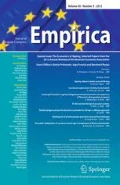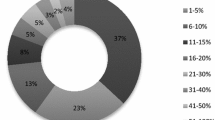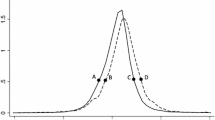Abstract
This paper analyzes the location (at home or abroad) and the mode of organization (outsourcing versus integration) of intermediate inputs production, using data on a sample of Italian manufacturing companies and focusing on the role of firm heterogeneity. We find evidence of a productivity ordering where foreign integration is chosen by the most productive firms and domestic outsourcing is chosen by the least productive firms; firms with medium-high productivity choose domestic integration, firms with medium-low productivity choose foreign outsourcing.
Similar content being viewed by others
Notes
After completing this paper, I became aware of research by Kohler and Smolka (2009), who use firm-level data for Spain with a similar structure to our data. They find that higher-productivity firms are more likely to acquire inputs from a vertically integrated supplier. This effect is stronger for high levels of capital intensity.
Unfortunately, the following waves of MCC surveys did not include questions on firms’ sourcing strategies. Such information was generally missing in other firm-level databases too. The results reported in this paper cannot therefore be taken as evidence on the most recent trends of the Italian economy.
The regression should not be thought of as a structural model, in which productivity is actually caused by explanatory variables. It should rather be interpreted as a way to get conditional means, i.e. the average productivity premia (or discounts) for firms following a given organizational form, relatively to other firms and conditional on a set of factors. The reader is referred to Sect. 4.3 for a discussion of endogeneity issues.
Data on skills and innovation are not available for 9.0% of firms in our sample (119 out 1,316 firms).
Unfortunately there is no information on productivity after 1997 in our data.
The results are robust to changes in the period over which the growth rate of productivity and its lagged level are measured.
References
Amiti M, Konings J (2007) Trade liberalization, intermediate inputs and productivity: evidence from Indonesia. Am Econ Rev 97(5):1611–1638
Antràs P (2003) Firms, contracts and trade structure. Q J Econ 118:1375–1418
Antràs P, Helpman E (2004) Global sourcing. J Polit Econ 112:552–580
Antràs P, Helpman E (2008) Contractual frictions and global sourcing. In: Helpman E, Marin D, Verdier T (eds) The organization of firms in a global economy. Harvard University Press, Cambridge
Antràs P, Rossi-Hansberg E (2008) Organizations and trade. NBER Working Paper, no. 14262
Baldwin JR, Gu W (2003) Export-market participation and productivity performance in Canadian manufacturing. Can J Econ 36(3):634–657
Bernard AB, Jensen JB (1999) Exceptional exporter performance: cause, effect or both? J Int Econ 47:1–25
Bernard AB, Jensen JB, Redding SJ, Schott PK (2007) Firms in international trade. J Econ Perspect 21(3):105–130
Bernard AB, Jensen JB, Redding SJ, Schott PK (2008) Intra-firm trade and product contractibility. Unpublished paper
Castellani D, Serti F, Tomasi C (2008) Firms in international trade: importers and exporters heterogeneity in the Italian manufacturing industry. LEM Working Paper, no. 4
Defever F, Toubal F (2007) Productivity and the sourcing modes of multinational firms: evidence from French firm-level data. CEP Discussion Paper, no. 842
Feenstra RC, Spencer BJ (2005) Contractual versus generic outsourcing: the role of proximity. NBER Working Paper, no. 11885
Glass AJ, Saggi K (2001) Innovation and wage effects of international outsourcing. Eur Econ Rev 45:67–86
Görg H, Hanley A, Strobl E (2008) Productivity effects of international outsourcing: evidence from plant-level data. Can J Econ 41(2):670–688
Greenaway D, Kneller R (2007) Firm heterogeneity, exporting and foreign direct investment. Econ J 117:F134–161
Grossman G, Helpman E (2004) Managerial incentives and the international organization of production. J Int Econ 63:237–262
Grossman G, Helpman E (2005) Outsourcing in a global economy. Rev Econ Stud 72:135–159
Grossman G, Helpman E, Szeidl A (2005) Complementarities between outsourcing and foreign sourcing. Am Econ Rev Papers Proc 95:19–24
Head K, Ries J (2003) Heterogeneity and the FDI versus export decision of Japanese manufacturers. J Jpn Int Econ 17:448–467
Helpman H (2006a) International organization of production and distribution, NBER Reporter: Research Summary, summer
Helpman H (2006b) Trade, FDI and the organization of firms. J Econ Lit 44:589–630
Helpman H, Melitz MJ, Yeaple SR (2004) Export versus FDI with heterogeneous firms. Am Econ Rev 94:300–316
Kasahara H, Rodrigue J (2008) Does the use of imported intermediates increase productivity? Plant-level evidence. J Dev Econ 87:106–118
Kohler W, Smolka M (2009) Global sourcing: evidence from Spanish firm-level data. Unpublished paper
Kurz CJ (2006) Outstanding outsourcers: a firm- and plant-level analysis of production sharing. Finance and Economics Discussion Series, Federal Reserve Board, no. 4
Levinsohn J, Petrin A (2003) Estimating production functions using inputs to control for unobservables. Rev Econ Stud 70:317–341
Melitz M (2003) The impact of trade on intra-industry reallocations and aggregate industry productivity. Econometrica 71(6):1695–1725
Muuls M, Pisu M (2009) Imports and exports at the level of the firm: evidence from Belgium. World Econ 32(5):692–734
Nunn N, Trefler D (2008) The boundaries of the multinational firm: an empirical analysis. In: Helpman E, Marin D, Verdier T (eds) The organization of firms in a global economy. Harvard University Press, Cambridge
Spencer B (2005) International outsourcing and incomplete contracts. Can J Econ 38(4):1107–1135
Tomiura E (2005) Foreign outsourcing and firm-level charachteristics: evidence from Japanese manufacturers. J Jpn Int Econ 19:255–271
Tomiura E (2007) Foreign outsourcing, exporting, and FDI: a productivity comparison at the firm level. J Int Econ 72:113–127
Yeaple SR (2006) Offshoring, foreign direct investment, and the structure of U.S. trade. J Eur Econ Assoc 4(2–3):602–611
Acknowledgments
I am grateful to an anonymous referee, Alfonso Rosolia, Luigi Federico Signorini, Marcel Smolka, Lucia Tajoli, Roberto Tedeschi, Davide Vannoni and participants to the 10th ETSG Conference in Warsaw, the 2nd FIW Research Conference “International Economics” in Vienna, the Centro Studi Luca d’Agliano Conference on “Innovation, Internationalization and Global Labor Markets” in Turin and the INFER Workshop on “Firm and Product Heterogeneity in International Trade” in Brussels for their useful comments. I am also grateful to Alessandra De Michele for editorial assistance. The views expressed in this paper are those of the author and do not necessarily reflect those of the Bank of Italy.
Author information
Authors and Affiliations
Corresponding author
Rights and permissions
About this article
Cite this article
Federico, S. Outsourcing versus integration at home or abroad and firm heterogeneity. Empirica 37, 47–63 (2010). https://doi.org/10.1007/s10663-009-9118-3
Published:
Issue Date:
DOI: https://doi.org/10.1007/s10663-009-9118-3




